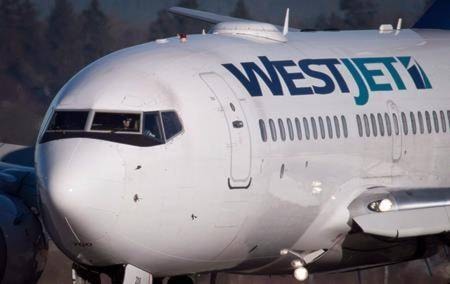Flying on WestJet’s low-cost carrier Swoop will come with a price: ancillary fees that will cost travellers about twice what they pay on the mainline carrier, the CEO of the Calgary-based airline said Tuesday.
Gregg Saretsky said he expects non-fare fees on Swoop, which is set to launch in June, will be very similar to so-called ultra low-cost carriers in the U.S.
“We’re about $19 per guest currently on the mainline operation and I would expect that we should be able to get (double) that on Swoop,” he said during a conference call Tuesday about its third-quarter results.
WestJet’s (TSX:WJA) fees for services like flight changes, cancellations and checked bags increased 12 per cent in the third quarter to $117 million, or $18.64 per passenger.
Between 60 and 70 per cent of Swoop travellers are expected to pay fees for carry-on and checked baggage, added Bob Cummings, who is heading up preparations to launch Swoop.
However, higher ancillary fees will be more than offset by lower airport charges and base fares, he said.
“Total ticket prices will be 30 to 40 per cent lower at the end of the day,” Cummings said in an interview.
He said Swoop should capture some of the equivalent of 30 to 35 planeloads of Canadians who fly daily out of U.S. border airports.
Swoop is set to launch with two 189-seat Boeing 737-800s. The fleet will increase to six planes by September and 10 in the summer of 2019.
Swoop’s network of longer haul flights and ancillary charges will be unveiled in February when tickets go on sale and will ultimately provide flights both in Canada and to the southern United States and sun destinations.
Modelled after the relationship between Australia’s Qantas Airways and Jetstar Airways Pty Ltd., Swoop will fly mostly to different destinations than WestJet, but may also supplement the larger airline on major city routes.
Saretsky said Swoop will operate as an independent airline with its own reservation system, operator’s certificate and airport check-in counters staffed by its own employees.
“We have been very resolute in wanting to build this at the absolute lowest (cost), so there will not even be connectivity between Swoop and WestJet,” he told analysts.
Passengers flying on Swoop from Calgary to Toronto, for example, will have to collect their bags and recheck them for corresponding flights to Sudbury.
Swoop’s financial results, however, will be incorporated with those of WestJet.
Ed Sims, WestJet’s commercial executive vice-president, said there is still significant demand in the Canadian market to stimulate traffic at lower fares, especially using secondary airports like Hamilton, Ont. and Abbotsford, B.C.
However, Cummings said WestJet believes there is room for only one major ultra-low cost carrier in Canada.
Unlike startup competitors like Canada Jetlines Ltd. which is also set to fly next summer, WestJet’s existing operations could be used to carry passengers in case of service disruptions.
Air Canada (TSX:AC) has said it will use its low-cost leisure travel subsidiary Rouge to compete on the very low-cost market in Canada.
Meanwhile, WestJet said it expects the new widebody Boeing 787s that will start entering its fleet in January 2019 will help attract more business travellers.
It plans to add lounges at its hubs in Calgary, Toronto and Vancouver and will increase the use of its mobile apps for bookings, check-in and prioritized boarding.
Saretsky said many Canadian corporations are looking for better deals because flying in Canada at the last minute can be expensive.
“So as much as Air Canada might fight back, we have a massive cost advantage and a product specifically designed to accommodate that type of traveller.”
WestJet saw its third-quarter profit grow by about 20 per cent compared with a year ago as it increased capacity and traffic.
The airline said it earned a record $138.4 million or $1.18 per diluted share for the quarter that ended Sept. 30. That compared with a profit of $116.0 million or 97 cents per diluted share in the same quarter last year.
Revenue totalled $1.22 billion, up from $1.12 billion, with premium economy seat revenues rising 19 per cent.
